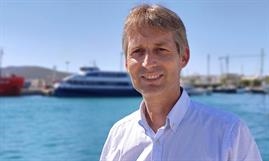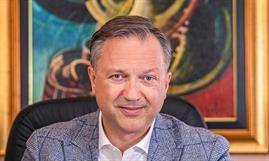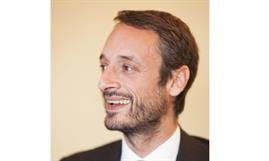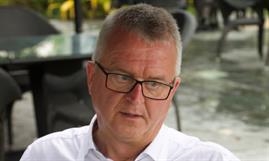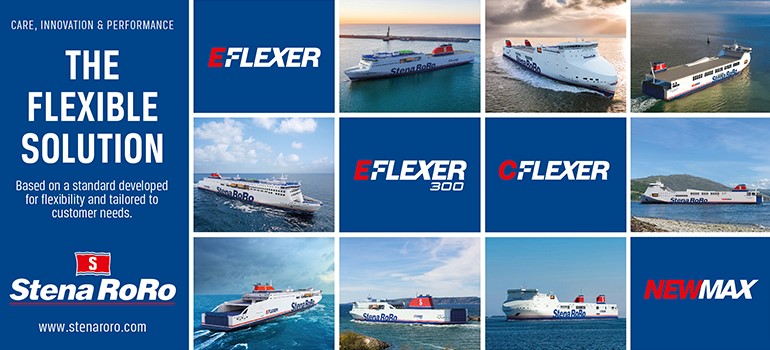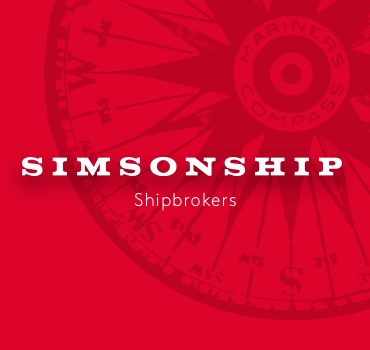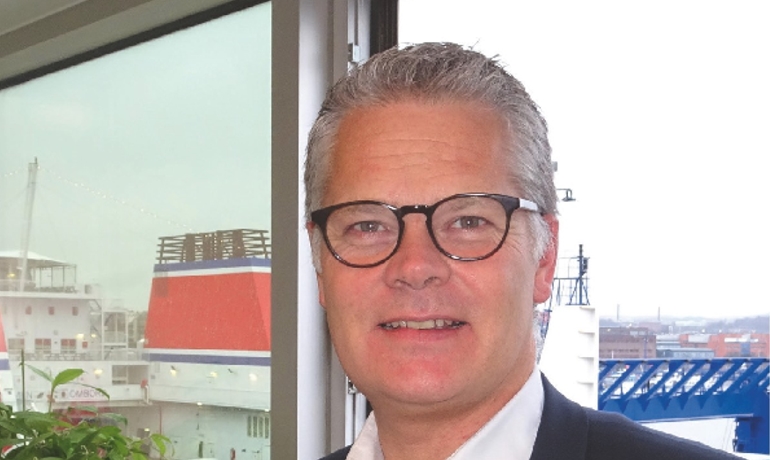
Niclas Mårtensson © Philippe Holthof
DISCOURSE WITH NICLAS MÅRTENSSON ON STRATEGIES, VISIONS, AND CHALLENGES
InterviewUpon the re-opening of the Halmstad-Grenå route, Shippax’s editor-in-chief conversed candidly with Stena Line’s CEO Niclas Mårtensson on challenges, opportunities and other issues the group was facing.
Operating 19 different routes crisscrossing the Baltic Sea, Scandinavia, the North Sea, and the Irish Sea, Stena Line is one of the ‘big three’ pan-European ferry operators. Unlike the other two, namely DFDS and Grimaldi Group, Stena Line – with a fleet of 28 ro-pax and nine ro-ro (two of them with 300-driver capacity) vessels – is primarily a ro-pax rather than a pure ro-ro operator.
With a total of nine links connecting Great Britain with the Netherlands, the Irish Republic, and Northern Ireland, Stena Line depends heavily on the UK market. Whilst the Brexit saga has caused nervousness and a hard Brexit, in practice, is still not off the table, Niclas Mårtensson told us that there were other things happening in the market besides the Brexit-related issues.
Shippax: To what extent did last year’s Brexit uncertainty affect your carrying volumes?
Niclas Mårtensson (NIM): Due to the Brexit uncertainty, 2019 was much harder to predict than we had thought. It was like a yo-yo, with ups and downs caused by the stockpiling ahead of the Brexit, which then didn’t materialize. But it was not just Brexit, the overall freight market started to weaken, as clouds gathered over the German economy.
On average we are happy, as freight volumes were on a par with 2018. But we don’t expect to grow our volumes in 2020, as the market is flattening out. The Polish economy slowed down and that’s why STENA NORDICA didn’t return as the fourth ship on the Karlskrona-Gdynia route.
The passenger business exceeded our expectations. We had a fantastic high season – the best in many years. The climate debate influenced many people, especially in Scandinavia, who chose not to fly and switch to more environmentally friendly transport modes. But we somehow also need to be prepared for the Greta Thunberg effect, as shipping will come under scrutiny.
Shippax: On the Channel, freight volumes surged during the first quarter of 2019 thanks to the stockpiling. They plunged after that. The Brexit also impacted the passenger market, as fewer people travelled to and from the UK. To what extent were your North Sea operations affected?
NIM: On our North Sea routes we had a positive Brexit effect with a year-on-year trailer increase of about six to seven per cent. The Dover routes, including the tunnel, saw their volumes shrink by the same percentage. We have seen a trend of ever more trailers being shipped unaccompanied, affecting the short routes and benefiting the longer ones. The reason for this is twofold: firstly, due to Brexit, hauliers switched to longer routes, as they feared being stuck in the Western Channel ports; secondly, the truck driver shortage still prevails.
As for the passenger and car market, our Hoek van Holland-Harwich route performed better than in 2018, so we didn’t feel any Brexit effect at all there, in fact, quite the opposite.
Shippax: What’s your growth strategy for the Hoek van Holland, as ships to both Harwich and Killingholme frequently set sail full to capacity?
NIM: We have successfully grown our business on the Hoek van Holland routes over the past ten years and are indeed frequently capacity-constrained, particularly on peak departures. We do still have room to grow and, furthermore, part of the strategy is to increase capacity on the Europoort routes, something illustrated by the recent charter of the 3,663-lanemetre HATCHE and QEZBAN to replace the smaller MISIDA and MISANA. This has enabled us to move certain volumes, which fit better on our Rotterdam services, from Hoek van Holland, effectively making it possible for us to grow further in Hoek van Holland.
Shippax: Is the capacity increase in the Europoort hub the only option to grow and has it been the main driver of the growth in recent years?
NIM: The overall growth on our North Sea services in recent years has been due to a combination of growths on all four routes, as we have strengthened and developed our hubs on both sides of the New Waterway. In 2010-11, we invested heavily in replacing our Hoek van Holland fleet by even larger newbuilds. In more recent years, as part of the strategic development of our freight transport hub to the UK, we’ve concentrated our North Sea capacity increases on Europoort while continuing to optimize our Hoek van Holland services.
Shippax: Competition on the Irish Sea is fierce, with both the freight and passenger markets having contracted. Was this Brexit-related?
NIM: Compared to 2018, the overall freight volumes on the Irish Sea dwindled by seven to eight per cent in 2019. The number of cars dropped by about five per cent. But we have done well and hardly lost volumes. We could feel the market was nervous on the back of Brexit – freight volumes therefore were slightly down. As Ireland is not a manufactory base, there was no stockpiling effect on the Irish Sea. The Irish Sea is a tight market, but competition is fair and fierce here. As there are no state-owned or subsidized operators, we compete on equal terms. But if you compete with fierce competitors, it means you need to be even more competitive, which is an everyday challenge.
Shippax: Ahead of Brexit and a possible no-deal one, direct services between the Continent and Ireland have gained importance, effectively eliminating the Great Britain land bridge. Has this affected your Irish Sea activities? Have you considered increasing your capacity on the Rosslare-Cherbourg link or start another direct service between Ireland and the Continent?
NIM: No, we will not add capacity now. Whatever happens, the Irish market will not get bigger. Fewer than seven million people live on the whole island; about five million of them in the Irish Republic. There is no hinterland and, as I’ve just explained, Ireland is not a manufactory base; its economy is based on agriculture and IT talents – something you don’t normally export physically.
We haven’t felt the competition from CLdN’s so-called Brexit busters. About 40 per cent of the freight moved between Great Britain and Ireland are consumer goods, most of them are time-sensitive, which requires shorter crossings and higher frequencies. Most of these consumer goods originate from Great Britain; so, there is not as much land bridge traffic as you might think.
Shippax: Irish Ferries added W.B. YEATS on its Dublin-Cherbourg route. How has this impacted your Rosslare-Cherbourg link?
NIM: Until a few years ago, Rosslare-Cherbourg wasn’t our best-performing route. Things have changed in a positive way. Following the introduction of W.B. YEATS, competition has intensified indeed. Irish Ferries already operated the route before, but as a product, W.B. YEATS is a new competitor to be reckoned with. As it fits its purpose we haven’t yet upgraded STENA HORIZON.
Shippax: Prime Minister Boris Johnson replaced the backstop by customs borders in the ports of Northern Ireland. As it looks now, Stena Line’s Belfast terminals will most likely become the border between Northern Ireland and Great Britain. How will you prepare for this change?
NIM: In all honesty, we have stopped being shocked by Brexit. Are we prepared? Prepared for what? It’s a sad story and things cannot be changed overnight. Once we know what is required in Belfast, we will fulfil it. But we cannot invest based on speculation.
Last year, and during the last quarter of 2018, I met several decision-makers in the UK to discuss the Brexit issue. But even if you agree things in London, it doesn’t mean they will agree in Brussels. We still need to wait and see what the final outcome will be.
Of course, we are already supporting our customers with all the necessary IT tools to tackle the administrative burden. But we can never take on the border-control responsibility in Belfast on behalf of the government. This would be wrong, as we are a private shipping company.
Shippax: The Birkenhead-Belfast ro-paxes, STENA LAGAN and STENA MERSEY, will be replaced by E-Flexer tonnage. What are your plans for these Visentini Class ships after their lengthening and conversion at Sedef Shipyard in Turkey?
NIM: The lengthening and conversion of STENA LAGAN and STENA MERSEY are a turnkey project. It’s something totally new for us.
We have lengthened and jumboized ships before, but the conversion to drive-through on both decks will be a challenge, as these ships were not future-proofed for drive-through operations. The lengthening will bring the capacities close to those of the E-Flexers.
It is part of our philosophy to have flexible tonnage so we don’t need to plan our fleet three years in advance. I can confirm that the ships will stay in Stena Line service; so, they are not modified for a third party. We haven’t yet decided where to put them because of the uncertainties I just explained, namely Brexit and weakening freight market. We will not be forced into a premature decision. Of course, we have a short list of routes for these ships, but we believe that for many of the routes in our network it’s better not to build purpose-built tonnage.
Shippax: In addition to the lengthened Visentini Class vessels, you will add five E-Flexers to your tally, with the first of which having already been introduced and the second to follow soon. STENA ESTRID, the first E-Flexer, has replaced STENA SUPERFAST X, which has been withdrawn from Stena Line service. Will more ships be disposed of, or are the lengthened Visentini units and the two last E-Flexers rather meant for organic growth?
NIM: It can either be for organic growth or for replacement; the market will dictate this. There is one big picture though: we will grow our capacity thanks to the new, bigger ships. It’s something fantastic from a sustainability perspective, as we can take more trucks off the roads without the need to operate extra sailings.
So, the fleet renewal is part of our strategy to connect Europe for a sustainable future. This is something we are doing step by step. It cannot be done overnight, as suitable technology is often not available yet. In the short run, taking more trucks off the road is a positive step towards global decarbonisation.
Shippax: STENA ESTRID has been successfully introduced between Holyhead and Dublin. What has been the customer feedback on this ship?
NIM: STENA ESTRID is a great product; she shows the way forward for Stena Line. She was introduced at a time when storms were raging over the Irish Sea and proved to cope extremely well. Passenger feedbacks have been very positive. But STENA ADVENTURER remains the flagship on the Holyhead service. She is a fantastic vessel, especially with public spaces having been revamped.
Shippax: STENA LAGAN and STENA MERSEY will be replaced by the E-Flexer Class STENA EDDA and STENA EMBLA. Both the ports of Birkenhead and Belfast have been adapted for the newbuilds. What was the scope of the works?
NIM: The works will be completed in time for STENA EDDA’s debut. In Belfast, especially, the works were quite significant. The layout of our Belfast VT2 terminal was redesigned to improve the traffic flows through. We’ve installed a new double-tier linkspan, automatic mooring to speed up the berthing and unberthing manoeuvres, as well as new mooring dolphins, which are necessary for accommodating the bigger vessels. In Birkenhead the existing linkspan and pontoon were refurbished, with a new upper linkspan added to allow double-deck loading and discharge. Like in Belfast, we redesigned the terminal layout to improve the traffic flows.
Shippax: Isn’t it counter-productive to operate two terminals in Belfast? What about reclaiming land, making an extension of VT4, and centralize all activities into one terminal?
NIM: If we review and decide to change the set-up, we will communicate that. Until then we do not speculate on terminal plan options.
Shippax: Brittany Ferries has announced that it will get STENA BALTICA back following the termination of her charter. It therefore appears that the Polish service is the most likely candidate for a fleet renewal, be it in the form of the Mk II E-Flexers, the lengthened Vistenini units, or, why not, putting STENA GERMANICA and STENA SCANDINAVICA on the route?
NIM: We have not yet externally communicated the destination for the Mk II E-Flexers and the lengthened Visentini vessels. We will do so in due course. Until then we do not wish to comment on this on account of businesses sensitivity.
Shippax: We can somehow expect a fleet reshuffle following the re-introduction of the lengthened Visentini units and the commissioning of the last two E-Flexers. Could this mean the end of the line for ageing ships like STENA GOTHICA and her sister ship URD?
NIM: We need to be a profitable business. For services with low passenger volumes and less demanding passengers like our Travemünde-Liepaja route, using older ships still makes sense. Actually, our passengers really like STENA GOTHICA and URD. There is a difference between dream and reality and, although I have a wish list, I need to deliver a financial result. Therefore, as it stands now, we have yet no plans to dispose of STENA GOTHICA and URD.
Shippax: The Gdynia-Nynäshamn freight-only route proved to be short-lived. When launched in autumn 2017, you said that the service had been introduced because of the customer demand. Didn’t customers support the route as much as you had hoped for?
NIM: There were various reasons why this route was short-lived, but it was primarily due to dynamics in the market. It proved to be a good learning experience for our organisation though. Once again it illustrated that we could be quick to seize the opportunities in the market. This, I am sure, will happen again.
Shippax: Although you are primarily a ro-pax operator, you also have some pure ro-ro ferries in your fleet. Short-sea ro-ro vessels of roughly 7,000 lanemetres seem to become the new normal, with DFDS having just introduced its HUMBRIA SEAWAYS on the Vlaardingen-Immingham route. Could ships of this size also be the way forward for Stena Line?
NIM: We have a different strategy and business platform from those of DFDS and CLdN. We don’t really believe in these big ro-ro ships – at least not today. And if we believed in them in the future, we would have already invested in them.
Ro-ro ships, just like cruise ships, are simply getting too big. Handling time in port for these juggernauts comes at a cost. In today’s world, where we want to reduce our emissions footprint and fuel bill, it’s important to keep port stays as short as possible and extend sailing time. Short-sea shipping is also all about frequency and the reliability of the frequency. So, we rather believe in frequency and a 3,100-to-3,600-lanemetre-intake vessel – like our E-Flexers – is optimal for the routes we ply.
Shippax: I understand that Stena has embarked upon designing a 2,700-lanemetre Heysham-max ro-ro newbuild. How is this project developing?
NIM: Because we were not yet convinced by these 7,000-lanemetre giants, smaller-capacity vessels could be an option indeed, not only for the Heysham-Belfast route but also for a number of other routes in our network. This has to do with flexibility once again. There are several different projects on the drawing board in our company, but whether or not they will ever become reality remains to be seen.
Shippax: There was a project on the table for a full-electric ferry for the Gothenburg-Frederikshavn route. The ship was dubbed STENA ELEKTRA. Is the project still alive? Stena RoRo’s Per Westling earlier told me that the E-Flexers most likely represented the last generation of fossil fuel-powered ro-pax ferries for Stena. There must be advanced plans for a ferry using alternative (non-fossil) fuels?
NIM: Like everyone else, we are following closely the development of alternative fuels. Emission-free fuels on a larger scale are needed, not only for shipping, but also for other transport modes. This is where we hope methanol can have a role to play. We believe there is also a strong case for hybrids in short-sea shipping in Europe, but that will require a lot of investments in grid and port infrastructure throughout the continent. Hydrogen is an interesting option, but some development is also needed to make it commercially and operationally viable. In the short term, we will focus mainly on efficiency matters, but the development of long-term alternatives is equally important, something that will likely not be driven predominantly by shipowners though.
Shippax: Besides the battery power, STENA ELEKTRA also featured a modular superstructure concept, which you described in an earlier interview with us. Could you elaborate on this modular concept? Is it still on course?
NIM: I think the technical aspect of this project is best answered by Stena Teknik, which has developed the design, but, yes, we are working hard to make STENA ELEKTRA a reality rather than just a concept. The work is on-going right now. With regard to the modular concept, this is still an option. The final decision will be taken when we eventually place the construction order.
Shippax: What has been the experience so far with the hybridization of STENA JUTLANDICA? It was a step-by-step process, from 1MWh in the first stage, increasing to 20MWh, and then to 50MWh. Are you still in the first stage? What is your ‘battery strategy’?
NIM: The battery experiment on STENA JUTLANDICA has worked out very well and we are currently looking at stage two, which will mean an increase in battery power to around 10 MWh. However, this is a moving target, depending on the performance of the ship, turnaround times, and prices of electricity, bunkers and batteries.
When we started with the hybridization of STENA JUTLANDICA in September 2018, our technicians said it was like “paying for 20 Tesla cars but only getting 12”. That is a part of the challenge here. At present we are in need of subsidies and incentives to make the case work; some parameters are moving in the desirable direction. We hope to have to take the step two in the project in three years’ time, but we haven’t decided yet on what ferry or which route. The ultimate goal is to have an all-electric ro-pax ferry in service by 2030, if all goes well.
Shippax: In recent times we have seen a further consolidation in the market, especially the ro-ro market. Probably the biggest news was the takeover of U.N. Ro-Ro by DFDS. In the long term, this is probably a wise move, as it makes DFDS less dependent on the UK market. Stena Line had earlier expanded beyond its comfort zone, into the Black Sea and Far East markets, but eventually withdrew from both. Will you again consider tapping into new markets, so that you will be less dependent on your core markets?
NIM: Our focus is to continue strengthening the solid route network we have today, continue to add capacity and grow with our customers. Both the E-Flexer project and the lengthening of STENA LAGAN and STENA MERSEY are testimonies of this. Currently we do not have any plans to expand our route network beyond the areas where we already operate.
Shippax: If you had such a plan tomorrow, would you carry it out by growing organically, through a takeover, or forming a JV?
NIM: Well, since we don’t have any current plans on such an expansion, we do not wish to speculate. But, historically, all the alternatives you mention have been possible solutions for Stena Line.
Shippax: What is the future of the Saßnitz route? SASSNITZ, the sole ship operating between Trelleborg and Saßnitz, has been used as an extra capacity on the Rostock service. What is the current situation and what’s the long-term plan with the Saßnitz route?
NIM: The current situation is that we continue as before. As you know, SASSNITZ is a rail-enabled ferry. She carries the passenger train that runs between Malmö and Berlin in the summer. Last year, we saw an increase in the number of passengers travelling with this train on the Trelleborg-Saßnitz ferry. This was a positive development. Our railway partner, Snälltåget, has decided to further increase the frequency this year. This is an example of how our markets are changing fast and our challenge is to move as fast. Please allow me not to comment further on the long-term plans of our route networks.
Shippax: In 2018 you discontinued the slot agreement with TT-Line. In an earlier conversation you told us that the market appreciated this slot agreement. If that was the case, why was it discontinued?
NIM: We appreciated the slot agreement and it worked well, but, after a closer scrutiny of the operation, we decided that we wanted to focus more on our own customers. Having said this, we still believe in capacity swaps as means of avoiding overcapacity and employing tonnage more efficiently, thereby also reducing emissions and fuel consumption.
Shippax: You are experimenting on the use of Japanese-style sleeping capsules on the Rostock ships. How have passengers responded to this feature? Will it also be introduced on other vessels?
NIM: They have been very successful. We’ve had over 5,500 bookings since September 2019. On medium-range routes, for many passengers it’s a good in-between solution instead of occupying a reclining seat or a cabin. We may introduce them on other ships plying medium-range routes, like SASSNITZ. But no decision on this has been taken yet.
The Trelleborg-Rostock route has enjoyed an impressive growth during the last three years, with a throughput of 400,000 passengers in 2019. We are investing EUR 5 million in a refit and renovation of the cabins and public spaces on board MECKLENBURG-VORPOMMERN and SKÅNE. This started in late December and will be completed in time for the peak 2020 season.
Shippax: You earlier also told us that the Kiel and Gothenburg (Majnabbe) terminals suffered capacity constraints, which jeopardized a further growth in freight carrying. Have things improved? What are the percentages of accompanied and unaccompanied freight on the Gothenburg-Kiel route?
NIM: There are still limitations in terminal space, but the port of Kiel is doing its best to help us grow. We are also focusing on intermodal operations. A new intermodal train service connecting Kiel with Luxemburg will commence shortly. The rail and ferry combined operation is very efficient, Moreover, the intermodal services increase efficiency and reduce emissions. We are working closely with our freight customers to offer more combinations like this.
Currently the share between accompanied and unaccompanied freight is about fifty-fifty, but we see a better growth potential in unaccompanied cargo transport units.
Shippax: Earlier, there were plans to centralize operations to one downstream terminal in Gothenburg, as there were no guarantees that you could stay at Masthuggskajen (Danish Terminal) and Majnabbe (German Terminal). This would negatively affect the foot passenger market. What’s today’s situation?
NIM: At present, we are confident that the Danish traffic will be able to stay in town for the foreseeable future. We have a good understanding with the city. We are constantly working to make sure that our operations contribute to the city’s development and not the other way around. The German traffic is less sensitive to the location and we have signalled that we are willing to move to the outer harbour if and when the city wishes us to do so. But there are currently no such plans.
Shippax: In September 2018, STENA VINGA replaced STENA GOTHICA as the third ship on the Gothenburg-Frederikshavn route. By doing so, you created extra sailings for motorist passengers. Has the introduction of STENA VINGA seen a surge in passenger carryings?
NIM: There was an increase in the volumes of passengers and cars, but the main aim of the replacement was to reduce the burden borne by STENA DANICA and STENA JUTLANDICA in passenger and car volume carrying during the summer. This would improve the onboard experience for our customers.
Shippax: Swedish media recently reported a possible intermediate call at Læsø by STENA VINGA. How realistic is this?
NIM: A joint project with the municipality of Læsø, investigating the viability of adding a call by STENA VINGA on her way to and from Frederikshavn, is underway. The big issue here is the need for Læsø to build a new port.
Shippax: Is the high-speed catamaran STENA CARISMA still in warm lay-up? The HSS 900 has been laid up for more than six years. How much longer will this continue?
NIM: We are constantly evaluating the employment of our ferries. We cannot comment on the future of STENA CARISMA or how long it will remain in lay-up at Masthugget.
Shippax: Today’s high-speed ferries are much more fuel efficient than those built twenty years ago. Would you consider re-entering the high-speed ferry market?
NIM:The focus of our largest investments in recent years has been on our flexible and efficient E-Flexer ro-pax ferries. Right now, we are happy to see them start operating on the Irish Sea.
Shippax: Could you tell us something about your environmental agenda?
NIM: Being sustainable in our operations is a must. We want to have a clean conscience when it comes to environmental protection matters and we want to be a responsible and caring company. We are working towards becoming a leader in sustainable shipping, but we still have a lot of work to do.
Shippax: Last but not least, what are your digital agenda and the experience you have gained from using AI?
NIM: By 2021,we want to become the world’s leading ferry company that is, to put it simply, assisted by AI and machine learning in all parts of our operation.
The level of assistance is different in different areas. Today, we are already using AI in several parts of our business. Stena Fuel Pilot, for example, has already helped to reduce fuel consumption on STENA SCANDINAVICA for up to two to three per cent per trip. The scheme is now live on board five of our vessels, with the latest addition being STENA NAUTICA in early January.
We are also using AI in forecasting, pricing, and customer services, among others. Personally, I am amazed by the rapid adoption of AI by companies in general and impressed by the speed Stena Line is moving into this area. The key has been people rather than technology. We have attracted the right experts. To help us achieve our goals, we have recruited a team highly qualified people; they include professors, people with doctorate degrees in AI and machine learning, and data scientists. We are also working with another specialist, who has a PhD in AI predictions, from KTH Royal Institute of Technology in Stockholm.
We have also created a collaborative environment for our endeavours by putting the people from business and the operations around the same table. The success of this initiative becomes obvious when we hear our head of AI, Lars Carlsson, and STENA SCANDINAVICA’s senior master, Jan Sjöström, describing how they have worked closely together on the bridges of various vessels, developing and continuously improving the Stena Fuel Pilot.
The discourse continues …
© Shippax / Philippe Holthof
mar 01 2020
Most read
Carnival Corporation full-year results
dec 21 2025
Not a Merry Christmas for CMAL and CalMac as two newbuilding ferries – GLEN ROSA and ISLE OF ISLAY - are further delayed
dec 22 2025


